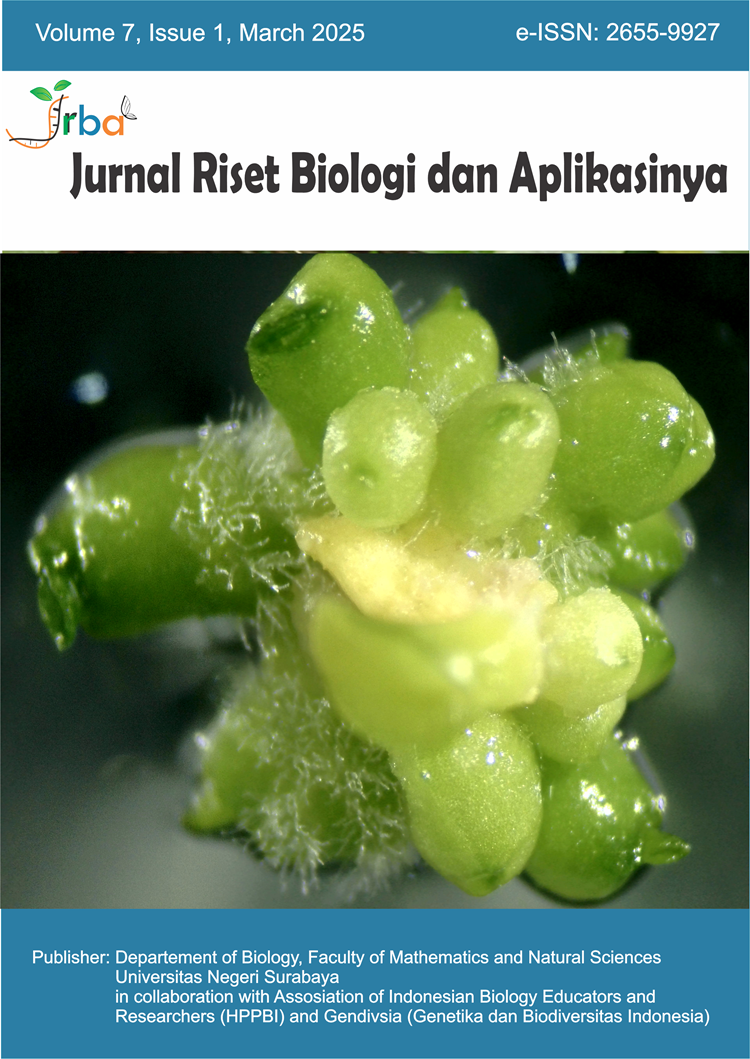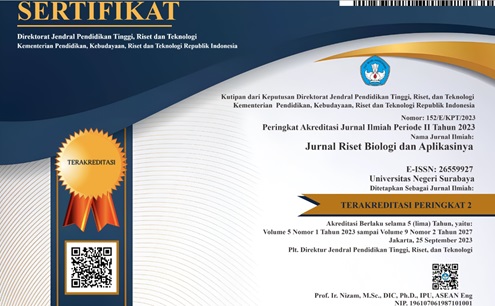DNA QR Code Using Internal Transcribed Spacer 1 (ITS1) Region of Commercial Cucumber Varieties (Cucumis sativus L.)
DOI:
https://doi.org/10.26740/jrba.v7n1.p1-7Keywords:
Digital systems; DNA barcoding; DQR code; Genetic labelingAbstract
DNA Quick Response (DQR) is an accurate, efficient, fast, and cost-effective alternative to PCR-based or other sequencing methods. DQR is the method integrated seamlessly with digital systems. The DQR could be apply as effective approach to preventing seed counterfeiting, for example in cucumber. This study aimed to identify DNA barcodes based on the ITS1 region and develop DQR for commercial cucumber varieties in Indonesia. Two cucumber varieties, namely cv. Mars and cv. Makka were used. The genomic DNA was extracted using commercial DNA purification kit. The DQR for these two cucumber varieties were developed based on experimental data from the ITS1 region. The efficiency and characterization of ITS1 region were evaluated through homology analysis using BLAST-NCBI and DQR development. The DQR of cucumber cv. Mars and cv. Makka based on ITS1 region were successfully developed. The length of the ITS1 region encrypted in the QR code was 496 bp and 437 bp for cv. Mars and cv. Makka, respectively. The A-T and G-C proportions for cv. Mars were 45.2% and 54.8%, respectively, while for cv. Makka, the A-T and G-C proportions were 42.6% and 57.4%, respectively. Our findings are valuable for genetic labeling and authentication of horticultural crops, especially cucumber.
References
Abiodun, O. A., & Adeleke, R. O. (2010). Comparative studies on nutritional composition of four melon seeds varieties. Pakistan Journal of Nutrition, 9(9), 905-908. https://doi.org/10.3923/pjn.2010.905.908
Ahmed, S., Ibrahim, M., Nantasenamat, C., Nisar, M. F., Malik, A. A., Waheed, R., Ahmed, M. Z., Ojha, S. C., & Alam, M. K. (2022). Pragmatic applications and universality of DNA barcoding for substantial organisms at species level: a review to explore a way forward. BioMed Research International, 11 (3), 1846485. https://doi.org/10.1155/2022/1846485
Antil, S., Abraham, J. S., Sripoorna, S., Maurya, S., Dagar, J., Makhija, S., Bhagat, P., Gupta, R., Sood, U., Lal, R., & Toteja, R. (2023). DNA barcoding, an effective tool for species identification: a review. Molecular Biology Reports, 50(1), 761-775. https://doi.org/10.1007/s11033-022-08015-7
Cai, Y., Li, P., Li, X., Zhao, J., Chen, H., Yang, Q., & Hu, H. (2016). Converting Panax ginseng DNA and chemical fingerprints into two-dimensional barcode. Journal of Ginseng Research, 41, 339-346. https://doi.org/10.1016/j.jgr.2016.06.006
Chakraborty, S., & Rayalu, S. (2021). Health Beneficial Effects of Cucumber. IntechOpen, London. http://dx.doi.org/10.5772/intechopen.96053
Communication and Information Service, East Java Province. (2020). how smartphone-based barcode applications can help farmers avoid counterfeit seeds at: https://kominfo.jatimprov.go.id/read/umum/manfaatkan-aplikasi-barcode-berbasis-smartphone-petani-terhindar-benih-palsu.
Department of Agriculture and Food of Bandung Regency. (2018). The Ministry of Agriculture Takes Firm Action Against Garlic Seed Producers and Distributors of Counterfeit Seeds. Accessed through: Dinas Pertanian dan Pangan Kabupaten Bandung at: https://diperpa.badungkab.go.id/berita/12504-kementan-tindak-tegas-penangkar-dan-pengedar-benih-bawang-putih-palsu.
Food and Agriculture Organization (FAO). (2020). Status of Seed Lesgislation and Policies in the Asia-Pacific Region. FAO.
Food and Agriculture Organization (FAO). (2024). Crops and livestock products. Accessed through: Food and Agriculture Organization of the United Nations at: https://www.fao.org/faostat/en/#data/QCL.
Gogoi, B., Wann, S. B., & Saikia, S. P. (2020). DNA barcodes for delineating Clerodendrum species of North East India. Scientific Reports, 10,13490. https://doi.org/10.1038/s41598-020-70405-3
Grumet, R., Lin, Y. C., Rett-Cadman, S., & Malik A. (2023). Morphological and genetic diversity of cucumber (Cucumis sativus L.) fruit development. Plants, 12, 1-21. https://doi.org/10.3390/plants12010023
Guo, Y., Gao, M., Liang, X., Xu, M., Liu, X., Zhang, Y., Liu, X., Liu, J., Gao, Y., Qu, S., & Luan, F. (2020). Quantitative trait loci for seed size variation in cucurbits – a review. Frontiers in Plant Science, 11, 304. https://doi.org/10.3389/fpls.2020.00304
Ho, V. T., & Nguyen, M. P. (2020). An in silico approach for evaluation of rbcL and matK loci for DNA barcoding of Cucurbitaceae family. Biodiversitas, 21(8), 3879-3885. https://doi.org/10.13057/biodiv/d210858
Faza, A.W., Hidaya, A.K., Yona, H.F., Pangestu, T.T., Safa, M.S., Suyanto, E., Turhadi & Fatchiyah. (2024). In silico evaluation of rbcL, matK, and psbA-trnH regions on the genus Spatholobus (Fabaceae). Jurnal Riset Biologi dan Aplikasinya, 6(2), 73-81. https://doi.org/10.26740/jrba. v6n2.p73-81.
International Seed Federation (ISF). (2018). Illegal Seed Practices – A Threat to Farmer Livelihoods, Food Security and Sustainable Agriculture. ISF.
Jiang, S., Chen, F., Qin, P., Xie, H., Peng, G., Li, Y., & Guo, X. (2022). The specific DNA barcodes based on chloroplast genes for species identification of Theaceae plants. Physiology and Molecular Biology of Plants, 28(4), 837-848. https://doi.org/10.1007/s12298-022-01175-7
Jiang, Z., Zhang, M., Kong, L., Bao, Y., Ren, W., Li, H., Liu, X., Wang, Z., & Ma, W. (2023). Identification of Apiaceae using ITS, ITS2 and psbA-trnH barcodes. Molecular Biology Reports, 50(1), 245-253. https://doi.org/10.1007/s11033-022-07909-w
Kaur, M., & Sharma, P. 2021. Recent advances in cucumber (Cucumis sativus L.). Journal of Horticultural Science and Biotechnology, 97(1), 3-23. https://doi.org/10.1080/14620316.2021.1945956
Khan, S. A., Baeshen, M. N., Ramadan, H. A., & Baeshen, N. A. (2017). Emergence of plastidial intergenic spacers as suitable DNA barcodes for arid medicinal plant Rhazya stricta. American Journal of Plant Sciences, 8(8), 1774-1789. https://doi.org/10.4236/ajps.2017.88121
Kress, W. J. (2017). Plant DNA barcodes: Applications today and in the future. Journal of Systematics and Evolution, 55(4), 291-307. https://doi.org/10.1111/jse.12254
Krishna, M. B., & Dugar, A. (2016). Product authentication using QR codes: A mobile application to combat counterfeiting. Wireless Personal Communications, 90(1), 381-398. https://link.springer.com/article/10.1007/s11277-016-3374-x
Kumar, S., Stecher, G., Li, M., Knyaz, C., & Tamura, K. (2018). MEGA X: Molecular evolutionary genetics analysis across computing platforms. Molecular Biology and Evolution, 35(6), 1547-1549. https://doi.org/10.1093/molbev/msy096
Li, H., Xiao, W., Tong, T., Li, Y., Zhang, M., Lin, X., Zou, X., Wu, Q., & Guo, X. (2021). The specific DNA barcodes based on chloroplast genes for species identification of Orchidaceae plants. Scientific Reports, 11(1), 1424. https://doi.org/10.1038/s41598-021-81087-w
Liandhajani. (2022). Counterfeiting products that harm business brand owners and consumers. Jurnal Manajemen Strategi dan Aplikasi Bisnis, 5(1), 73-82. https://doi.org/10.36407/jmsab.v5i1.609
Liu, C., Shi, L., Xu, X., Li, H., Xing, H., Liang, D., Jiang, K., Pang, X., Song, J., & Chen, S. (2012). DNA barcode goes two-dimensions: DNA QR code web server. PLoS ONE, 7(5), e35146. https://doi.org/10.1371/journal.pone.0035146
Lv, Y. N, Yang, C. Y., Shi, L. C., Zhang, Z. L., Xu, A. S., Zhang, L. X., Li, X. L., & Li, H. T. (2020). Identification of medicinal plants within the Apocynaceae family using ITS2 and psbA-trnH barcodes. Chinese Journal of Natural Medicines, 18(8), 594-605. https://doi.org/10.1016/s1875-5364(20)30071-6
Ma, S., Lv, Q., Zhou, H., Fang, J., Cheng, W., Jiang, C., Cheng, K., & Yao, H. (2017). Identification of traditional she medicine shi-liang tea species and closely related species using the ITS2 barcode. Applied Sciences, 7(3), 195. https://doi.org/10.3390/app7030195
Ministry of Agriculture, Republic of Indonesia. (2022). Buku Statistik Konsumsi Tahun 2022. Kementerian Pertanian RI.
Nehal, N., Choudhary, B., Nagpure, A., & Gupta, R. K. (2021). DNA barcoding: a modern age tool for detection of adulteration in food. Critical Reviews in Biotechnology, 41(5), 767-791. https://doi.org/10.1080/07388551.2021.1874279
Pan, Y., Wang Y., McGregor, C., Liu, S., Luan F., Gao, M., & Weng, Y. (2020). Genetic architecture of fruit size and shape variation in cucurbits: a comparative perspective. Theoretical and Applied Genetics, 133(1), 1-21. https://doi.org/10.1007/s00122-019-03481-3
Regional Government of West Java Province. (2022). Polda Jabar Bongkar Pemalsuan Merek Benih Hortikultura. Accessed through: Pemerintah Daerah Provinsi Jawa Barat at: https://jabarprov.go.id/berita/polda-jabar-bongkar-pemalsuan-merek-benih-hortikultura-794.
Saputra I. Y. (2022). Polda Jateng Musnahkan Ribuan Benih Jagung Syngenta Palsu. Accessed through: Espos Indonesia at: https://jateng.solopos.com/polda-jateng-musnahkan-ribuan-benih-jagung-syngenta-palsu-1455244.
Sharief, S. A., Chahal, P., & Alocilja, E. (2021). Application of DNA sequences in anti-counterfeiting: Current progress and challenges. International Journal of Pharmaceutics, 1(602), 120580. https://doi.org/10.1016/j.ijpharm.2021.120580
Taberlet, P., Coissac, E., Pompanon, F., Gielly, L., Miquel, C., Valentini, A., Vermat, T., Corthier, G., Brochmann, C., Willerslev, E. 2007. Power and limitations of the chloroplast trnL (UAA) intron for plant DNA barcoding. Nucleic Acids Research, 35(3), e14. https://doi.org/10.1093/nar/gkl938
Trivedi, S., Rehman, H., Saggu, S., Panneerselvam, C., & Ghosh, S. K. (2020). DNA Barcoding and Molecular Phylogeny. 2nd Edition. Springer.
Turhadi & Hakim, L. (2023). In-silico evaluation of chloroplast loci for DNA barcoding on genus Stelechocarpus (Annonaceae). Agro Bali: Agricultural Journal, 6(1), 56-64, https://doi.org/10.37637/ab.v6i1.1105.
Turhadi, Sudarjayanti BN, Solihah FM, Azrianingsih R, Afiyanti M, Arumingtyas EL. 2024. Molecular identification of Scopellaria marginata from East Java, Indonesia, based on trnL-UAA and trnL-trnF intergenic spacer regions. Nusantara Bioscience, 16(1), 111-118. https://smujo.id/nb/article/view/16971/7577
Urumarudappa, S. K. J., Tungphatthong, C., Jaipaew, J., Pornputtapong, N., Pakdeesattayapong, D., Vimolmangkang, S., & Sukrong, S. (2022). Development of a DNA barcode library of plants in the Thai Herbal Pharmacopoeia and monographs for authentication of herbal products. Science Reports, 12(1), 9624. https://doi.org/10.1038/s41598-022-13287-x
Vanany I., Andri, K. B., Mardiyanto, R., Puspita N. F., & Winarsih, W. H. (2014). An electronic traceability system for an Indonesian fresh fruit supply chain. IPTEK Journal of Proceeding Series, 1(1), 493-496. http://dx.doi.org/10.12962/j23546026.y2014i1.297
Yao, R., Guo, R., Liu, Y., Kou, Z., & Shi, B. (2022). Identification and phylogenetic analysis of the genus Syringa based on chloroplast genomic DNA barcoding. PLoS ONE, 17(7), e0271633. https://doi.org/10.1371/journal.pone.0271633
Yu, N., Gu, H., Wei, Y., Zhu, N., Wang, Y., Zhang, H., Zhu, Y., Zhang, X., Ma, C., & Sun, A. (2016). Suitable DNA barcoding for identification and supervision of Piper kadsura in chinese medicine markets. Molecules, 21(9), 1221. https://doi.org/10.3390/molecules21091221
Zhu, S., Liu, Q., Qiu, S., Dai, J., & Gao, X. (2022). DNA barcoding: an efficient technology to authenticate plant species of traditional Chinese medicine and recent advances. Chinese Medicine, 17(112), 1-17. https://doi.org/10.1186/s13020-022-00655-y
Downloads
Published
How to Cite
Issue
Section
License
Copyright (c) 2025 Jurnal Riset Biologi dan Aplikasinya

This work is licensed under a Creative Commons Attribution-NonCommercial 4.0 International License.
 Abstract views: 361
,
Abstract views: 361
, PDF Downloads: 443
PDF Downloads: 443












